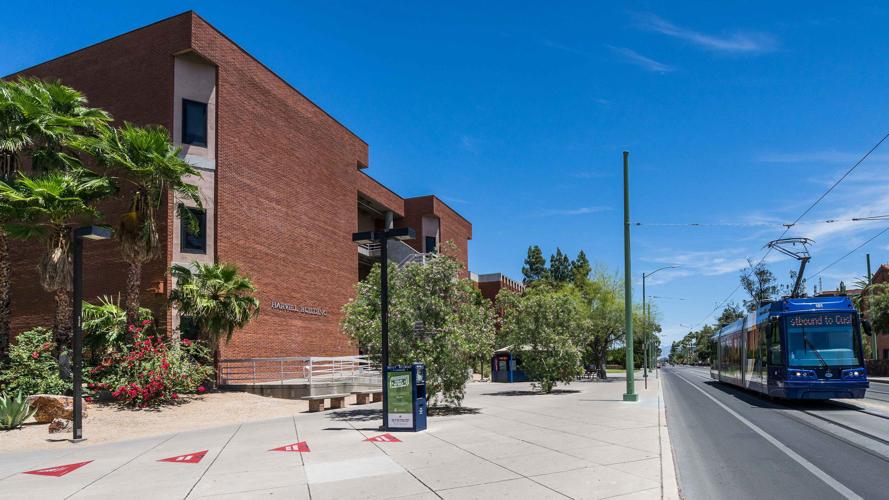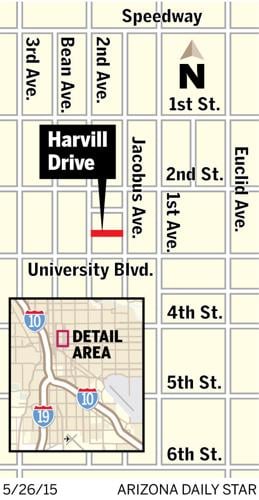Note to readers: This is a reprint of a 2015 article.
Richard A. Harvill oversaw a major expansion of the University of Arizona campus and programs in his 20 years as university president during what he regarded as the “Golden Age” of colleges.
He was born to Young F. and Fannie (Williams) Harvill on Aug. 29, 1905, in Centerville, Tennessee. In the 1910 U.S. Census, his father was listed as a farmer and his mother a homemaker. By 1920 the family had moved to Madison County, Mississippi.

The UA Student Union Memorial Building was completed early in President Harvill’s term of office and was formally dedicated during his three-day inauguration in November 1951.
He received his undergraduate degree in economics from what is now called Mississippi State University in 1926, his master’s degree from Duke University and his doctorate from Northwestern University.
He relocated to Tucson in 1934, moving near the University of Arizona campus, at 1007 N. Palm Drive. He took a job as assistant professor of economics, at a time when the whole university faculty and staff was about 150 people.
Two years later he wed Miss George Garner, whom he likely met in college, and then taught economics from 1937 to 1938 at the University of Buffalo in New York before returning to Tucson.
He worked in Phoenix at the Office of Price Administration during World War II, serving first as an assistant and then as district Price executive.
Harvill returned to the UA campus for the third time, serving in the capacity as dean of the Graduate College and professor of economics during 1946-47; later that year he was named dean of Liberal Arts College.
On Dec. 16, 1950, the state Board of Regents appointed him president of the University of Arizona. He replaced Dr. J. Byron McCormick, who had resigned the position the month before so he could return to full professorship in the school’s College of Law effective on June 30 of the following year.
When interviewed about the decision to choose Harvill, Sam Morris, president of the board, said: “Dr. Harvill, who has served as dean of the university graduate school and more recently of the liberal arts college, has done a splendid administrative job in the largest college on campus, and is well qualified for the president’s position.”
Harvill officially became the UA president on July 1, 1951.
His inauguration program, which lasted three days in November 1951, also included the formal unveiling of three important advances in the university’s existence.
This period included the first public showing of the Gila Pueblo Archaeological Collection, at an open house of the Arizona State Museum. This assemblage included 50,000 pieces of archaeological material donated from the Gila Pueblo Archaeological Foundation. This group of items was valued at $1 million, at that time one of the biggest gifts to the university.
The second item was the Kress Collection that had been placed on indefinite loan to the university by the Samuel H. Kress Foundation. The collection consisted of 25 masterpieces of 13th- to 19th-century European art. Inauguration guests viewed these at the library on campus, but the collection was later moved to the UA Museum Of Art.
The Student Union Memorial Building was dedicated on the final day. The building was the result of years of effort on the part of the state, the regents, faculty, alumni and students. It is a memorial to honor the 285 faculty members and students who lost their lives in World War I and World War II.
Cleon T. Knapp, president of the Board of Regents, delivered a dedication address that, in part, said:

“We now dedicate this beautiful building as a memorial to those who were once a part of the student body or faculty of this University of Arizona and who gave their lives for their country. ... We knew them in the days when they strolled about the campus — played their part in parts in university life, won scholastic honors, and received cheers upon our athletic fields. This memorial will forever be their shrine. I should like to think that, even at this moment, their spirits hover over us in silent appreciation of the tribute we now pay them.”
He went on to describe the memorial further:
“A bell hangs in the memorial tower. A bell that was once on the battleship Arizona, which sank in the mud and slime of Pearl Harbor. The bell is clean now — it has been purified by the tragedy of a great war. It is the voice through which this memorial shall forever speak. In the hours of great national achievement in war or peace, it will speak in ringing tones of joy; it will ring with pride when honors come to this university. But when the bell speaks in sadder moments, we shall know ‘for whom the bell tolls.’ ”
Years later, Harvill spoke of his tenure as president: “I came on the scene as president at a pretty good time. The 1950s and ’60s was the golden age of the university. There was so much progress made at the university because the economic condition was favorable.”
During his 20 years as president from 1951 to 1971, the university grew and expanded in many areas. There were a total of 45 buildings constructed, four new colleges were established — Nursing, Medicine, Architecture and Earth Sciences. Enrollment and faculty increased markedly. Institutions such as the University of Arizona Press, KUAT and the development of observatories at Kitt Peak were established during his tenure.
Harvill presided over two important celebrations in the history of the university, the 75th anniversary of the school and the nationwide Land-Grant Centennial.
After he retired in 1971, he was named president emeritus and continued to be part of the university. In 1981, the Richard A. Harvill Building was built along Second Street, not too far from Harvill’s original home at 1007 N. Palm Drive.
Harvill died in 1988.
The University of Arizona's Campus Agricultural Center is a living piece of Tucson history







